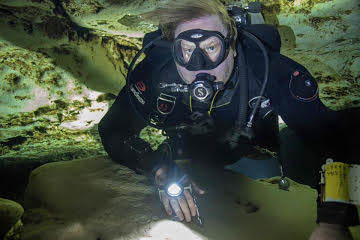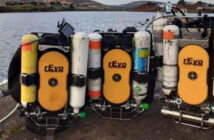It has been said that cave diving is one of the most dangerous sports in America. That is because in a cave you cannot always get directly to the surface. It can become a big problem if a diver does not manage his or her gas properly.
Matt Lerpiniere, of Kingston Ontario, has just completed two cave-diving courses in Florida. He says many of the cave-diving fatalities involve untrained divers. “It becomes much safer for divers who have trained. A lot of divers who have died were going beyond their training level or were not trained at all. Sometimes it’s just a medical emergency or simply an ‘open water’ diving death. If you follow the rules and training it (cave diving) is very safe.”
Matt first experienced the sport in Mexico, where he was doing some ocean diving. It turned into a “trust-me dive” into a cave, led by an experienced cave diver. “The rock formations were amazing. From there I started through a lengthy process to qualify as a cave diver.” There are four more courses he can take with Technical Diving International. However, the two courses he has taken qualify him for most dives he wants to do now.
A central factor in guarding against becoming lost in a cave is a line that runs through it. The main line usually begins inside the opening so divers who have not been trained in caves won’t see it and enter it. Cave divers can follow the main line and often carry reels that enable them to tie a line to the main line or to something stationary.
The main line is now referred to as the “gold line.” A diver lost her life thinking she was on the main line and her dive buddy’s attempts to point out her mistake failed. It was decided to use a gold main line so such a tragedy would not happen again. When they follow the gold line they will soon see an arrow showing the exit direction. Matt says some cave divers carry markers that they put on line and hook a reel to it.
Lerpiniere says caves often have a flow that usually is going out of the cave. “But some spots are flowing into the cave and there is some where it changes direction.” Consequently, flows are not as reliable as lines.
There are no cave diving sites to speak of in Canada but one is being developed in an old under-water iron-ore mine that was abandoned more than 50 years ago. Matt says a couple of Canadian divers have explored and mapped it, as well as installing permanent guide lines. He plans to dive there in May.
While there is little or no marine life found in underwater caves, you may find stalagmites and stalactites. Stalagmites rise from a cave’s floor from deposits of drippings from the ceiling. A stalactite is formed and hangs from the ceiling. Eventually, the two will fuse and form pillars.
For Matt Lerpiniere, the attraction of cave diving is seeing the impressive rock formations, as well as the challenges of the dive.











